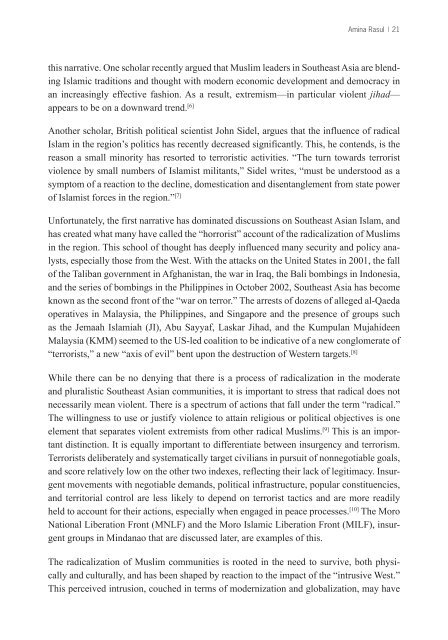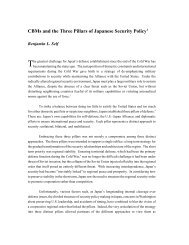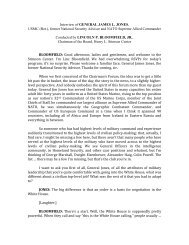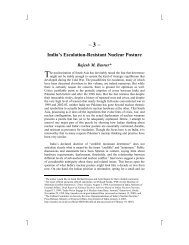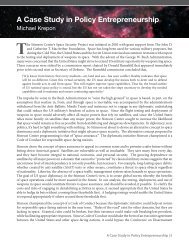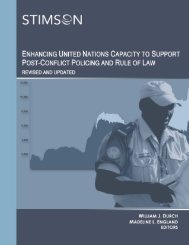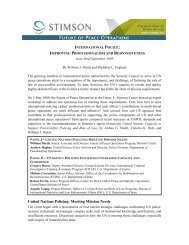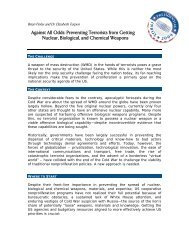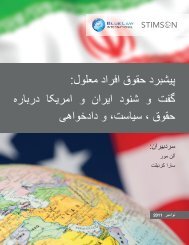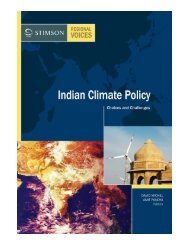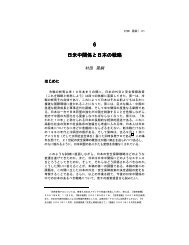Islam and Politics - The Stimson Center
Islam and Politics - The Stimson Center
Islam and Politics - The Stimson Center
You also want an ePaper? Increase the reach of your titles
YUMPU automatically turns print PDFs into web optimized ePapers that Google loves.
Amina Rasul | 21<br />
this narrative. One scholar recently argued that Muslim leaders in Southeast Asia are blending<br />
<strong>Islam</strong>ic traditions <strong>and</strong> thought with modern economic development <strong>and</strong> democracy in<br />
an increasingly effective fashion. As a result, extremism—in particular violent jihad—<br />
appears to be on a downward trend. [6]<br />
Another scholar, British political scientist John Sidel, argues that the influence of radical<br />
<strong>Islam</strong> in the region’s politics has recently decreased significantly. This, he contends, is the<br />
reason a small minority has resorted to terroristic activities. “<strong>The</strong> turn towards terrorist<br />
violence by small numbers of <strong>Islam</strong>ist militants,” Sidel writes, “must be understood as a<br />
symptom of a reaction to the decline, domestication <strong>and</strong> disentanglement from state power<br />
of <strong>Islam</strong>ist forces in the region.” [7]<br />
Unfortunately, the first narrative has dominated discussions on Southeast Asian <strong>Islam</strong>, <strong>and</strong><br />
has created what many have called the “horrorist” account of the radicalization of Muslims<br />
in the region. This school of thought has deeply influenced many security <strong>and</strong> policy analysts,<br />
especially those from the West. With the attacks on the United States in 2001, the fall<br />
of the Taliban government in Afghanistan, the war in Iraq, the Bali bombings in Indonesia,<br />
<strong>and</strong> the series of bombings in the Philippines in October 2002, Southeast Asia has become<br />
known as the second front of the “war on terror.” <strong>The</strong> arrests of dozens of alleged al-Qaeda<br />
operatives in Malaysia, the Philippines, <strong>and</strong> Singapore <strong>and</strong> the presence of groups such<br />
as the Jemaah <strong>Islam</strong>iah (JI), Abu Sayyaf, Laskar Jihad, <strong>and</strong> the Kumpulan Mujahideen<br />
Malaysia (KMM) seemed to the US-led coalition to be indicative of a new conglomerate of<br />
“terrorists,” a new “axis of evil” bent upon the destruction of Western targets. [8]<br />
While there can be no denying that there is a process of radicalization in the moderate<br />
<strong>and</strong> pluralistic Southeast Asian communities, it is important to stress that radical does not<br />
necessarily mean violent. <strong>The</strong>re is a spectrum of actions that fall under the term “radical.”<br />
<strong>The</strong> willingness to use or justify violence to attain religious or political objectives is one<br />
element that separates violent extremists from other radical Muslims. [9] This is an important<br />
distinction. It is equally important to differentiate between insurgency <strong>and</strong> terrorism.<br />
Terrorists deliberately <strong>and</strong> systematically target civilians in pursuit of nonnegotiable goals,<br />
<strong>and</strong> score relatively low on the other two indexes, reflecting their lack of legitimacy. Insurgent<br />
movements with negotiable dem<strong>and</strong>s, political infrastructure, popular constituencies,<br />
<strong>and</strong> territorial control are less likely to depend on terrorist tactics <strong>and</strong> are more readily<br />
held to account for their actions, especially when engaged in peace processes. [10] <strong>The</strong> Moro<br />
National Liberation Front (MNLF) <strong>and</strong> the Moro <strong>Islam</strong>ic Liberation Front (MILF), insurgent<br />
groups in Mindanao that are discussed later, are examples of this.<br />
<strong>The</strong> radicalization of Muslim communities is rooted in the need to survive, both physically<br />
<strong>and</strong> culturally, <strong>and</strong> has been shaped by reaction to the impact of the “intrusive West.”<br />
This perceived intrusion, couched in terms of modernization <strong>and</strong> globalization, may have


